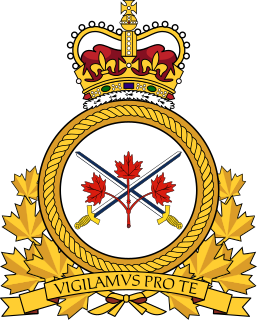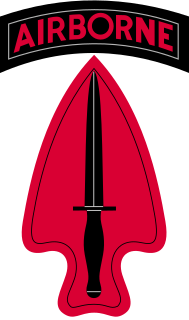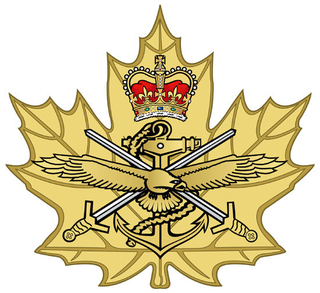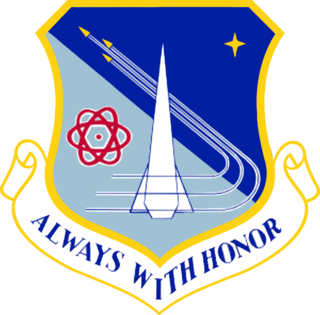Related Research Articles

The Canadian Armed Forces, or Canadian Forces, are the unified armed forces of Canada, as constituted by the National Defence Act, which states: "The Canadian Forces are the armed forces of Her Majesty raised by Canada and consist of one Service called the Canadian Armed Forces."

The Canadian Army is the command responsible for the operational readiness of the conventional ground forces of the Canadian Armed Forces. As of 2018 the Army has 23,000 regular soldiers, about 17,000 reserve soldiers, including 5,000 rangers, for a total of 40,000 soldiers. The Army is also supported by 3,000 civilian employees from the civil service. It maintains regular forces units at bases across Canada, and is also responsible for the Army Reserve, the largest component of the Primary Reserve. The Commander of the Canadian Army and Chief of the Army Staff is Lieutenant-General Wayne Eyre.

The Army Reserve is the active-duty volunteer reserve force and integrated element of the British Army. It should not be confused with the Regular Reserve whose members have formerly served full-time. The Army Reserve was previously known as the Territorial Force from 1908 to 1921, the Territorial Army (TA) from 1921 to 1967, the Territorial and Army Volunteer Reserve (TAVR) from 1967 to 1979, and again the Territorial Army (TA) from 1979 to 2014.

The 1st Special Forces Operational Detachment-Delta (SFOD-D), commonly referred to as Delta Force, Combat Applications Group (CAG), "The Unit", Army Compartmented Element (ACE), or within JSOC as Task Force Green, is an elite special operations force of the United States Army, under operational control of the Joint Special Operations Command. The unit is tasked with specialized missions primarily involving counter-terrorism, hostage rescue, direct action, and special reconnaissance, often against high-value targets. Delta Force and its Navy and Air Force counterparts, DEVGRU and 24th Special Tactics Squadron, are the U.S. military's primary Tier 1 special mission units tasked with performing the most complex, classified, and dangerous missions directed by the National Command Authority.

The Armed Services Vocational Aptitude Battery (ASVAB) is a multiple choice test, administered by the United States Military Entrance Processing Command, used to determine qualification for enlistment in the United States Armed Forces. It is often offered to U.S. high school students when they are in the 10th, 11th and 12th grade, though anyone eligible for enlistment may take it.

The Individual Ready Reserve (IRR) is a category of the Ready Reserve of the Reserve Component of the Armed Forces of the United States composed of former active duty or reserve military personnel and is authorized under 10 U.S.C. § 1005. For soldiers in the National Guard of the United States, its counterpart is the Inactive National Guard (ING). As of 22 June 2004, the IRR had approximately 112,000 members composed of enlisted personnel and officers, with more than 200 Military Occupational Specialties are represented, including combat arms, combat support, and combat service support.

The Cadet Instructors Cadre (CIC) Branch consists of approximately 7,500 Canadian Forces (CF) officers whose primary duty is the safety, supervision, administration and training of Royal Canadian Sea, Army, and Air Cadets. The Branch is the largest single group within the Canadian Forces reserve force subcomponent Cadet Organizations Administration and Training Service (COATS) and is the largest officer branch in the Canadian Forces. The COATS subcomponent of the Reserve Force employs members from all branches and occupations of the Royal Canadian Navy, Canadian Army, and Royal Canadian Air Force of the Canadian Forces.

The Air Force Reserve Command (AFRC) is a major command (MAJCOM) of the United States Air Force, with its headquarters at Robins Air Force Base, Georgia. It is the federal Air Reserve Component (ARC) of the U.S. Air Force, consisting of commissioned officers and enlisted airmen.

Officer Training School (OTS) is a United States Air Force and United States Space Force commissioning program located at Maxwell Air Force Base in Montgomery, Alabama.

The Canadian Forces Military Police (CFMP) provide police, security and operational support services to the Canadian Armed Forces (CF) and the Department of National Defence (DND) worldwide.

The United States Navy Reserve (USNR), known as the United States Naval Reserve from 1915 to 2005, is the Reserve Component (RC) of the United States Navy. Members of the Navy Reserve, called reservists, are enrolled in the Selected Reserve (SELRES), the Individual Ready Reserve (IRR), the Full Time Support (FTS), or the Retired Reserve program.

A reservist is a person who is a member of a military reserve force. They are otherwise civilians, and in peacetime have careers outside the military. Reservists usually go for training on an annual basis to refresh their skills. This person is usually a former active-duty member of the armed forces, and they remain a reservist either voluntarily, or by obligation. In some countries such as Israel, Norway, Singapore, and Switzerland, reservists are conscripted soldiers who are called up for training and service when necessary.
The Queen's Regulations and Orders for the Canadian Forces (QR&O) are regulations having the force of law for the governance of the Canadian Forces. They are regarded as the primary document of military law and regulations in Canada – aside from the National Defence Act.
A direct commission officer (DCO) is a United States uniformed officer who has received a commission without the typical prerequisites for achieving a commission, such as attending a four-year service academy, a four-year or two-year college ROTC program, or one of the officer candidate school or officer training school programs, the latter OCS/OTS programs typically slightly over three months in length.

The Primary Reserve of the Canadian Armed Forces is the first and largest of the four sub-components of the Canadian Forces reserves, followed by the Supplementary Reserve, the Canadian Rangers, and the Cadet Organizations Administration and Training Service.

The Marine Corps Mobilization Command (MOBCOM) is a major subordinate command (MSC) of Marine Forces Reserve and provides support for all Individual Ready Reserve (IRR), Individual Mobilization Augmentee (IMA) and Mobilized Training Unit Marine reservists. It falls under the Force Headquarters Group.

The Army Reserve Command is a major support command of the Philippine Army. It was created for the sole purpose of reserve force management, organization and Government Arsenal procurement.
In July 2008 the Post-9/11 GI Bill was signed into law, creating a new robust education benefits program rivaling the WWII Era GI Bill of Rights. The new Post 9/11 GI Bill, which went into effect on August 1, 2009, provides education benefits for service members who served on active duty for 90 or more days since September 10, 2001. These benefits are tiered based on the number of days served on active duty, creating a benefit package that gives current and previously activated National Guard and Reserve members the same benefits as active duty servicemembers.

The Marine Forces Reserve, also known as the United States Marine Corps Reserve (USMCR) and the U.S. Marine Corps Forces Reserve, is the reserve force of the United States Marine Corps. It is the largest command, by assigned personnel, in the U.S. Marine Corps. Marines in the Reserve go through the same training and work in the same Military Occupational Specialties (MOS) as their active-duty counterparts.
The reserve components of the United States Armed Forces are military organizations whose members generally perform a minimum of 39 days of military duty per year and who augment the active duty military when necessary. The reserve components are also referred to collectively as the National Guard and Reserve.
References
- ↑ "DAOD 2020-4, Supplementary Reserve"
- 1 2 "Parliamentary Committee Hearings 9 November 1995